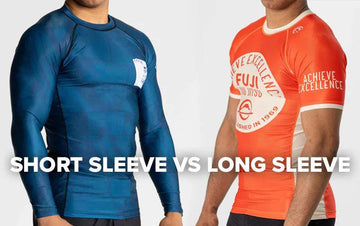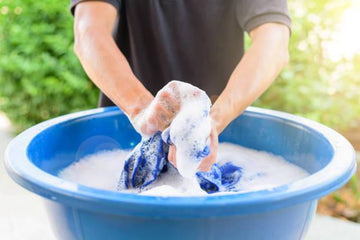Introduction to Rash Guards
Rash guards have become an essential part of water sports gear, offering protection and comfort to athletes and enthusiasts alike. Whether you're into surfing, swimming, or any other water activity, a rash guard can make a significant difference in your performance and overall experience. These versatile garments come in various styles, including short sleeve rash guards, long sleeve rash guards, and sleeveless rash guards, each catering to different needs and preferences.
Understanding the differences between these types of rash guards is crucial for selecting the best rash guard for your specific activities. Short sleeve rash guards provide a balance of protection and flexibility, making them ideal for warm weather and high-movement sports. Long sleeve rash guards offer more coverage, protecting your arms from sunburn and abrasions, which is particularly beneficial for extended periods in the water. Sleeveless rash guards, on the other hand, maximize freedom of movement and are perfect for those who prioritize agility and comfort.
In this guide, we will delve into the unique features and benefits of each type, helping you make an informed decision. Whether you're looking for a surf rash guard, swimming rash guard, or an athletic rash guard for other water sports, understanding these differences will ensure you choose the right gear for your needs.
The Evolution of Rash Guards in Sports
The evolution of rash guards in sports is a fascinating journey. Initially designed to protect surfers from board rashes, these versatile garments have become essential water sports gear. From the early days of basic designs, rash guards have transformed into high-performance athletic wear. Today, they cater to a wide range of activities, including surfing, swimming, and other water sports.
Modern rash guards come in various styles, such as short sleeve rash guards, long sleeve rash guards, and sleeveless rash guards. Each type offers unique benefits, making it easier for athletes to choose the best rash guard for their needs. The development of advanced materials and technology has significantly improved the comfort, durability, and functionality of these garments.
As the popularity of water sports continues to grow, so does the demand for high-quality rash guards. Whether you're looking for a surf rash guard or a swimming rash guard, understanding the evolution of these garments helps appreciate their importance in enhancing performance and protection. The continuous innovation in rash guard design ensures that athletes can enjoy their favorite water activities with confidence and style.
Short Sleeve Rash Guards: Features and Benefits
Short sleeve rash guards are a popular choice among water sports enthusiasts. These versatile pieces of water sports gear offer a balance between protection and flexibility. Designed to cover the upper body while leaving the arms free, short sleeve rash guards are ideal for activities that require a wide range of motion.
One of the primary benefits of a short sleeve rash guard is its ability to provide UV protection. When you're out in the sun for extended periods, a short sleeve rash guard can shield your skin from harmful UV rays, reducing the risk of sunburn. This makes it an excellent choice for surfers and swimmers who spend a lot of time in the water.
Another advantage is the comfort and breathability that short sleeve rash guards offer. Made from lightweight, quick-drying materials, these rash guards keep you cool and dry, even during intense activities. The snug fit ensures that the rash guard stays in place, preventing chafing and irritation.
For those who engage in athletic water sports, a short sleeve rash guard provides the perfect blend of protection and mobility. Whether you're paddling out to catch a wave or swimming laps in the pool, the short sleeves allow for unrestricted arm movement, enhancing your performance.
In terms of style, short sleeve rash guards come in a variety of designs and colors, allowing you to express your personality while staying protected. From sleek, minimalist designs to bold, vibrant patterns, there's a short sleeve rash guard to suit every taste.
Overall, short sleeve rash guards are a versatile and practical choice for anyone involved in water sports. They offer essential protection, comfort, and style, making them a staple in any water sports gear collection.
Long Sleeve Rash Guards: Features and Benefits
Long sleeve rash guards are a staple in the world of water sports gear. They offer extensive coverage, making them ideal for those who spend long hours in the sun or in the water. The full-length sleeves provide excellent protection against UV rays, which is crucial for surfers and swimmers who are exposed to the sun for extended periods.
One of the standout features of long sleeve rash guards is their ability to prevent chafing. The snug fit and smooth fabric reduce friction, ensuring that your skin remains irritation-free even during intense activities. This makes them a popular choice for surf rash guards and swimming rash guards alike.
In terms of versatility, long sleeve rash guards are unmatched. They are suitable for a wide range of water sports, from surfing to paddleboarding to snorkeling. The added coverage also helps in keeping you warm in cooler waters, making them a great option for those who engage in water activities year-round.
When it comes to choosing the best rash guard, long sleeve options often come out on top due to their comprehensive protection and comfort. Whether you're looking for an athletic rash guard for high-performance activities or a casual one for leisurely swims, long sleeve rash guards offer a perfect blend of functionality and style.
In the next section, we'll explore sleeveless rash guards and how they compare to their short sleeve and long sleeve counterparts. Stay tuned to find out which type of rash guard suits your needs best.
Sleeveless Rash Guards: Features and Benefits
Sleeveless rash guards are a versatile option in the world of water sports gear. They offer a unique blend of freedom and protection, making them a popular choice for many athletes. The absence of sleeves allows for maximum arm mobility, which is crucial for activities like swimming and surfing. This design ensures that your movements are not restricted, providing an edge in performance.
One of the standout features of sleeveless rash guards is their lightweight nature. Without the extra fabric on the arms, these rash guards are often lighter and more breathable. This can be particularly beneficial in warmer climates or during intense physical activities where overheating is a concern. The sleeveless design also allows for better ventilation, keeping you cool and comfortable.
When it comes to protection, sleeveless rash guards still offer the essential benefits. They provide a barrier against UV rays, reducing the risk of sunburn during extended periods in the sun. Additionally, they help prevent skin irritation caused by friction with surfboards or other equipment. This makes them a reliable choice for both casual and competitive water sports enthusiasts.
In terms of style, sleeveless rash guards come in a variety of designs and colors. This allows you to express your personal taste while enjoying the functional benefits. Whether you prefer a sleek, minimalist look or a bold, vibrant design, there is a sleeveless rash guard to match your preferences.
Overall, sleeveless rash guards are an excellent option for those seeking a balance between freedom of movement and essential protection. They cater to a wide range of water sports, from surfing to swimming, making them a versatile addition to any athlete's gear collection. As you consider your options, keep in mind the specific demands of your chosen activity and how a sleeveless rash guard can enhance your performance and comfort.
Comparing the Three Types: Which One is Right for You?
When it comes to selecting the best rash guard for your water sports activities, understanding the differences between short sleeve, long sleeve, and sleeveless options is crucial. Each type of rash guard offers unique benefits tailored to specific needs and preferences.
Short Sleeve Rash Guards: These are perfect for those who seek a balance between protection and flexibility. Short sleeve rash guards provide ample coverage for the upper body while allowing for greater arm movement. They are ideal for warm weather conditions and activities like surfing and swimming where full arm coverage isn't necessary.
Long Sleeve Rash Guards: Offering maximum coverage, long sleeve rash guards are the go-to choice for those who need extra protection from the sun and abrasions. They are particularly beneficial for surfers and swimmers who spend extended periods in the water. The long sleeves help in reducing the risk of sunburn and provide a layer of warmth in cooler waters.
Sleeveless Rash Guards: For those who prioritize unrestricted movement, sleeveless rash guards are the best option. They offer the least coverage but provide the highest level of flexibility. These are great for activities that require a full range of motion, such as paddleboarding or certain types of athletic training.
Choosing the right rash guard depends on your specific needs and the type of water sport you engage in. Whether you prefer the balanced protection of a short sleeve rash guard, the comprehensive coverage of a long sleeve rash guard, or the freedom of a sleeveless rash guard, there is a perfect option for everyone. Consider your activity, climate, and personal comfort to make the best choice.
Material and Fabric Considerations
When selecting the best rash guard for your water sports activities, understanding the material and fabric is crucial. The fabric of a rash guard significantly impacts its performance, comfort, and durability. Most rash guards are made from a blend of spandex and polyester or nylon. These materials offer excellent stretch, allowing for a snug fit that moves with your body during intense activities.
Short sleeve rash guards, long sleeve rash guards, and sleeveless rash guards each have unique fabric considerations. Short sleeve rash guards often use lightweight, breathable materials to keep you cool while providing protection. Long sleeve rash guards, on the other hand, might incorporate thicker fabrics to offer more coverage and UV protection, making them ideal for extended periods in the sun.
Sleeveless rash guards are designed for maximum mobility and are typically made from ultra-lightweight fabrics. This design is perfect for those who prioritize freedom of movement over coverage. When comparing rash guards, consider the specific needs of your sport. Surf rash guards, for instance, might require more durable fabrics to withstand the rigors of the waves, while swimming rash guards might focus on reducing drag in the water.
Additionally, the best rash guard for athletic activities should have moisture-wicking properties to keep you dry and comfortable. Look for fabrics that dry quickly and resist chafing, ensuring you stay focused on your performance. By understanding the material and fabric considerations, you can make an informed decision and choose the perfect rash guard for your water sports gear collection.
Care and Maintenance Tips for Rash Guards
Proper care and maintenance of your rash guard are crucial to ensure its longevity and performance. Whether you have a short sleeve rash guard, long sleeve rash guard, or sleeveless rash guard, following these tips will help you keep your water sports gear in top condition.
First, always rinse your rash guard with fresh water after each use. This helps remove salt, chlorine, and other residues that can degrade the fabric. For a surf rash guard or swimming rash guard, this step is especially important as these environments can be harsh on materials.
When washing your rash guard, use a mild detergent and avoid bleach or fabric softeners. These chemicals can weaken the fabric and reduce its elasticity. Hand washing is preferred, but if you must use a washing machine, place the rash guard in a mesh laundry bag to protect it from snagging.
Drying your rash guard properly is also essential. Avoid wringing it out, as this can stretch the fabric. Instead, gently squeeze out excess water and lay it flat to dry in a shaded area. Direct sunlight can cause colors to fade and materials to break down faster.
Store your rash guard in a cool, dry place away from direct sunlight. Avoid folding it in ways that can create permanent creases. For long sleeve rash guards, hanging them can help maintain their shape and prevent wrinkles.
By following these care and maintenance tips, you can ensure that your athletic rash guard remains in excellent condition, providing you with the best performance and comfort for all your water sports activities.
Conclusion: Making the Final Decision
When it comes to making the final decision on the best rash guard for your needs, it's essential to consider your specific requirements and preferences. Each type of rash guard—short sleeve, long sleeve, and sleeveless—offers unique benefits tailored to different activities and conditions.
If you prioritize flexibility and freedom of movement, a sleeveless rash guard might be your top choice. It's perfect for those who engage in high-intensity water sports where unrestricted arm movement is crucial. On the other hand, a short sleeve rash guard strikes a balance between protection and mobility, making it a versatile option for various water activities.
For those who need maximum coverage and protection from the sun, a long sleeve rash guard is the way to go. It provides excellent UV protection and is ideal for extended periods in the water, whether you're surfing, swimming, or participating in other water sports.
Ultimately, the best rash guard for you will depend on your specific needs and the type of water sports you enjoy. By understanding the differences and benefits of each type, you can make an informed decision that enhances your performance and comfort in the water.





